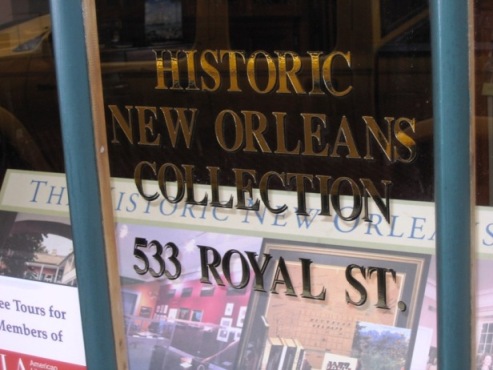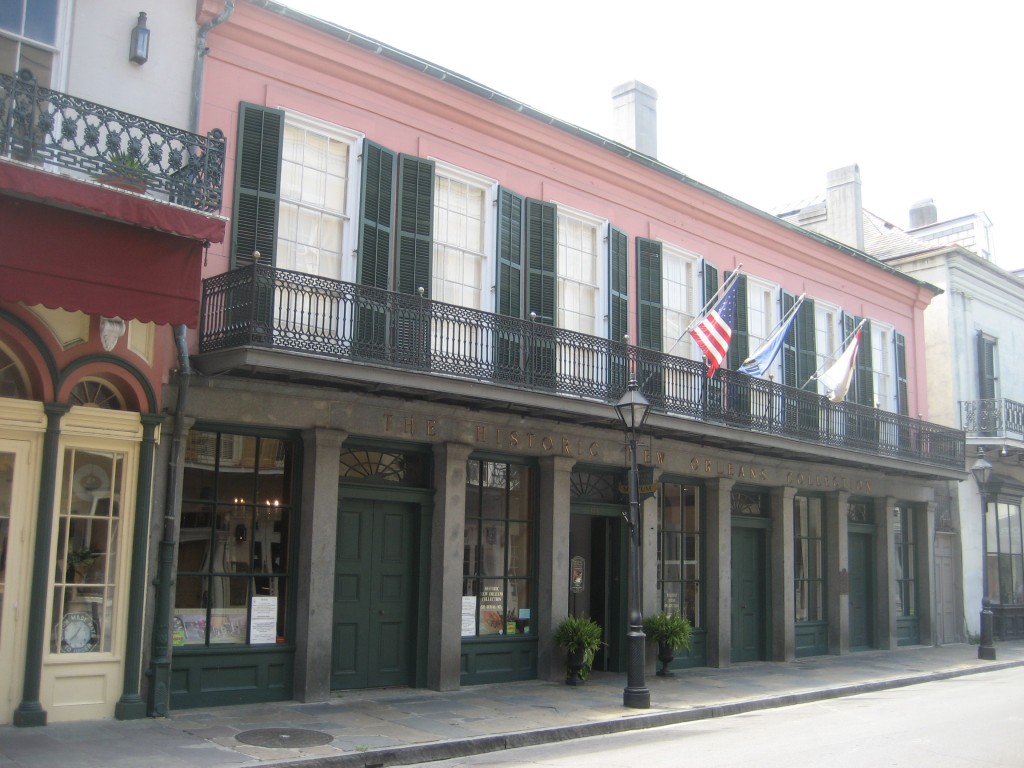Posts tagged History of Mardi Gras
“Myth, Mayhem & Majesty: A History of Mardi Gras in New Orleans.”
0
Myth, Mayhem and Majesty: A History of Mardi Gras in New Orleans follows the city’s Carnival traditions, beginning with the celebrations during the French and Spanish colonial periods and in the early days of statehood.
Tuesday–Sunday, February 1–March 4 • Daily at 2:00 p.m. Admission is $5, free for THNOC members. No reservations will be taken for the tour. Discover the origins of New Orleans’s Carnival traditions with Myth, Mayhem & Majesty: A History of Mardi Gras in New Orleans. The popular themed tour of The Collection’s Louisiana History Galleries examines the evolution of Mardi Gras from the colonial period through today and will reveal the insider’s perspective to the fanfare. Featured items from The Collection’s permanent holdings include the earliest written account of Mardi Gras in New Orleans from 1730, a Rex invitation from 1896, and a queen’s scepter from 1920. Please note, The Historic New Orleans Collection will be closed Mardi Gras weekend, Saturday, March 5–Tuesday, March 8.
533 Royal Street • New Orleans, LA 70130
504-523-4662, 504-523-4662 Hours: Tuesday – Saturday 9:30 – 4:30
Royal Street Complex also open on Sunday 10:30 – 4:30
History of Mardi Gras
2

March 7, 1885 Harper's Weekly illustration, , artist John Durkin. Art courtesy of Historic New Orleans Collection
Mardi Gras – Fat Tuesday – is the day before Lent begins. In 1512, the Butchers’ Guild of Paris created the tradition of leading a fattened ox, the “Boeuf Gras”, through the streets to celebrate the last feast before the rigors of Lent.
In its earliest form, Mardi Gras is probably linked to pagan rites celebrating the return of spring. Ancient Rome’s Lupercalia, a lusty fertility festival, was celebrated yearly on February 15. The young Catholic Church, unable to obliterate the pagan festivals, adopted and purified many: Carnival as a pre-Lenten celebration was born.
Pierre LeMoyne Sieur d’Iberville, arriving at the Mississippi River on Mardi Gras eve, 1699, named his encampment “Bayou and Pointe de Mardi Gras.” In the 1700’s, the French settlers continued to celebrate Mardi Gras.
Masquerades were regulated on a discretionary basis during the years Spain ruled New Orleans. Whenever the peace was threatened, a short-term police ban on masking was invoked. Balls, rather than parades, were favored. The Quadroon balls, known for their beautiful women, and most spectacular during Carnival, thrived during the end of the eighteenth and first half of the nineteenth centuries.
Because of the French “Boeuf Gras” tradition, it is safe to assume that New Orleanians paraded before the newspaper accounts of 1837-38, which record the processions of maskers in decorated carriages, on horseback and afoot. Mention of the Mobile, Alabama Cowbellions as Carnival participants also appears in newspapers about this time.
By the 1850’s, troublemakers had invaded the ranks of the maskers and were tossing dirt, flour, and even lye at the spectators instead of the traditional dragees (sugar coated fruits and nuts) and bon-bons, leading to a city ordinance against the “throws” and a proposed ban on parading. While Mardi Gras parades were declining in quality, there were definite bright spots; the carefully planned 1852 parade by the Company of Bedouins is considered the finest prior to Comus.
The parades of 1855 and 1856 were especially bleak, but events were taking place that would vastly improve Carnival. In the early 1850’s, a number of individuals from Mobile moved to New Orleans. Some of them had been members of the Mobile Cowbellion De Rakin Society, the first parading New Year’s Eve club. They missed the New Year’s Eve parades back home, and after experiencing a few of the New Orleans Mardi Gras processions, decided to form a secret Mardi Gras club in New Orleans similar to Mobile’s New Year’s Eve organizations.
Led by Joseph Ellison and Thad Smith, they obtained costumes from the Cowbellions and the Strikers Independent Society (another Mobile club) for their new Carnival parade in New Orleans. Thus the Mistick Krewe of Comus was born, legitimizing New Orleans Mardi Gras parades. Attended by torch bearers, Comus rode on one float, Satan on another, and approximately 75 devil maskers cavorted on foot.
After the Civil War, during Reconstruction, the Twelfth Night Revelers (1870), Rex, and Momus (both 1872) were formed. Rex introduced daytime parading to Carnival. Ten years later, Proteus was organized, followed by the Jefferson City Buzzards (a marching club) in 1890. Zulu, a black krewe, originally a spoof of Rex, was formed in 1909.
Alla, Mid-City, Hermes, and the first truck parade, the Elks Orleanians, began in the 1930’s, and the first parading women’s krewe, Venus, preceded World War II. After the war, many new organizations, the majority from the suburbs, began parading. The number of major parades doubled and tripled, reaching a high of more than fifty.
In the early 1950’s, mules were phased out of float pulling, being replaced by tractors. 1960 saw the birth of a major new throw, the aluminum doubloon. Carnival 1969 was the inaugural parade of Bacchus, the first krewe to have jumbo “Super Floats” and a celebrity non-local King.
The krewe of Mardi Gras first used decorated paper cups as a throw in 1975. The next year, Alla introduced a decorated plastic cup, which for a couple of decades became the most popular throw. That cup was made by a local company, Giacona Container Corp.
1979 was the year of the infamous Orleans Parish Police strike, resulting in the cancellation of most major Orleans parades and the temporary move of others to the suburbs. Carnival recovered from this ordeal
Momus, Comus and Proteus stopped parading in the 1990’s, but continue to hold masked balls. Proteus returned to the parade route a number of years later. It is said that a number of Comus and Momus members ride in a relatively new parade, Chaos.
The 1990’s saw the diversification of throws, including a wider assortment of small toys, and a huge assortment of stuffed animals, and some new throws, including lighted beads. Doubloons have lost some favor, but still exist in small numbers. In the last few years, a number of krewes throughout the metro New Orleans area have stopped parading. The reasons are many, including a shortage of krewe members, and the high cost of krewe dues, throws, and parade insurance.
The new century saw a standardization of parade routes, with most krewes rolling down St. Charles Avenue. August 29, 2005 brought Hurricane Katrina, which severely impacted Carnival. The season was shortened by 20%, less parades rolled, the parades were shorter with less floats and bands. Many hotel rooms were not available.
Want to know more about the history and traditions of the New Orleans Mardi Gras? Read these fine books: Mardi Gras, by Robert Tallant (Doubleday & Co.,1949); New Orleans Masquerade: Chronicles of Carnival, by Arthur Burton LaCour (Pelican Publishing Co.,1952); Mardi Gras! A Celebration, by Mitchell Osborne and Errol Laborde (Picayune Press, 1981); The Mistick Krewe, by Perry Young, (Carnival Press, 1931); and If Ever I Cease to Love: One Hundred Years of Rex, by Charles Dufour (School of Design, 1970).
Famous Parades Past: Comus 1873 Momus 1877
0 Think Krewe du Vieux or Krewe d’Etat are the most satirical? How about Muses and Momus? Consider these New Orleans parades from long ago.
Think Krewe du Vieux or Krewe d’Etat are the most satirical? How about Muses and Momus? Consider these New Orleans parades from long ago.
Two 1870s parades are famous for the controversy they created concerning the big issue of the day, Reconstruction.
The 1873 Comus procession titled “The Missing Links to Darwin’s Origin of the Species” and the 1877 Momus parade named “Hades – A Dream of Momus” ridiculed the carpetbaggers who ravaged the war torn South in the decade following the Civil War.
New Orleans was a troubled city during the Reconstruction era, and by 1873 on Carnival Krewe had enough. The members of Comus, behind the relative security of their masks, decided to let their feelings known. The 1873 Comus procession was noteworthy for a second reason – it was the first constructed entirely in New Orleans, all others having been at least partially built in France.
But it is the satirical aspects of this Comus parade that are best remembered. Comus ended the tradition of political neutrality with a flourish, depicting the carpetbaggers and Republicans as pests and misfits. President Grant was a boll Weevil. The stir created by the parade was immense, locals loving it and carpetbaggers hating it equally as much.
One year later, in 1974, a major riot occurred on Canal Street between the Metropolitan Police, run by the carpetbaggers, and the White League, the organization of the badgered citizens of New Orleans. The major Carnival parades were cancelled as a result. When 1876 rolled around, the city was again in a desperate condition due to the contested state and federal elections that year.
The two Presidential candidates, Republican Rutherford B. Hayes, and Democrat Samuel J. Tilden, were quarreling over the Presidency and an electoral commission was formed to settle the question. The Louisiana electoral vote was about to go to Hayes, giving the election to the Republican candidate by one vote.
On the state side of the election, two gubernatorial candidates had a similar feud going on. S. B. Packard, the Republican carpetbagger, had the might of the Federal armed forces behind his effort while Francis T. Nicholls, the Democrat, had the support of the populace- he was the a Confederate war hero, having given his left arm in one battle and his left foot in another.
Obviously prepared for the official outcry, Momus paraded on February 8, 1877. They were hours overdue because the floats proved too big for the den doors. When the obstructing wall was finally ripped out, it was 10 pm. The crowd was waiting.
The people’s response was immediate- they loved it! The floats satirized and ridiculed the carpetbagger chiefs and Republican officeholders from the local to the national level, including President Grant. Each float recreated Hades, the abode of the dead, the gloomy subterranean home of departed spirits. The float riders depict the scalawags (white Southern Reconstructionists who acted as Republicans) and other regional and national Republicans as every manner of odd creature imaginable.
With the ensuing Republican outcry rising, and retaliation from Washington a possibility, Nicholls, who had been hoping for official recognition of his victory from the Federal Government, decided to act fast. He wired an apology to the nation’s capital, even though he was a strong supporter of Carnival. Nicholls was afraid that the new President, Hayes, would dash his hopes of keeping the Governorship of Louisiana. Nicholls ended up as Governor, but Momus didn’t utilize satire again until the one hundredth anniversary of this memorable procession. Their return to satirizing local politics and trends was welcome, and they continue to do so.

